At 8,751 feet, Guadalupe Peak is the highest point in Texas. Hiking to this peak is one of the best things to do in Guadalupe Mountains National Park. This is a tough hike but the views from the top are unbeatable. In this guide, we cover everything you need to know to hike to Guadalupe Peak and climb to the “Top of Texas.”
Guadalupe Peak Hiking Stats
Distance: 8.4 miles out-and-back
Total Ascent: 3,000 feet
Difficulty: Strenuous
Time: 5 to 8 hours
When to Go: The trail is open all year. Spring and fall are the best times to do this hike, when temperatures are mild. During the summer months, expect hot weather, and plan on getting a very early start to beat the midday heat. In the winter, it can get below freezing.
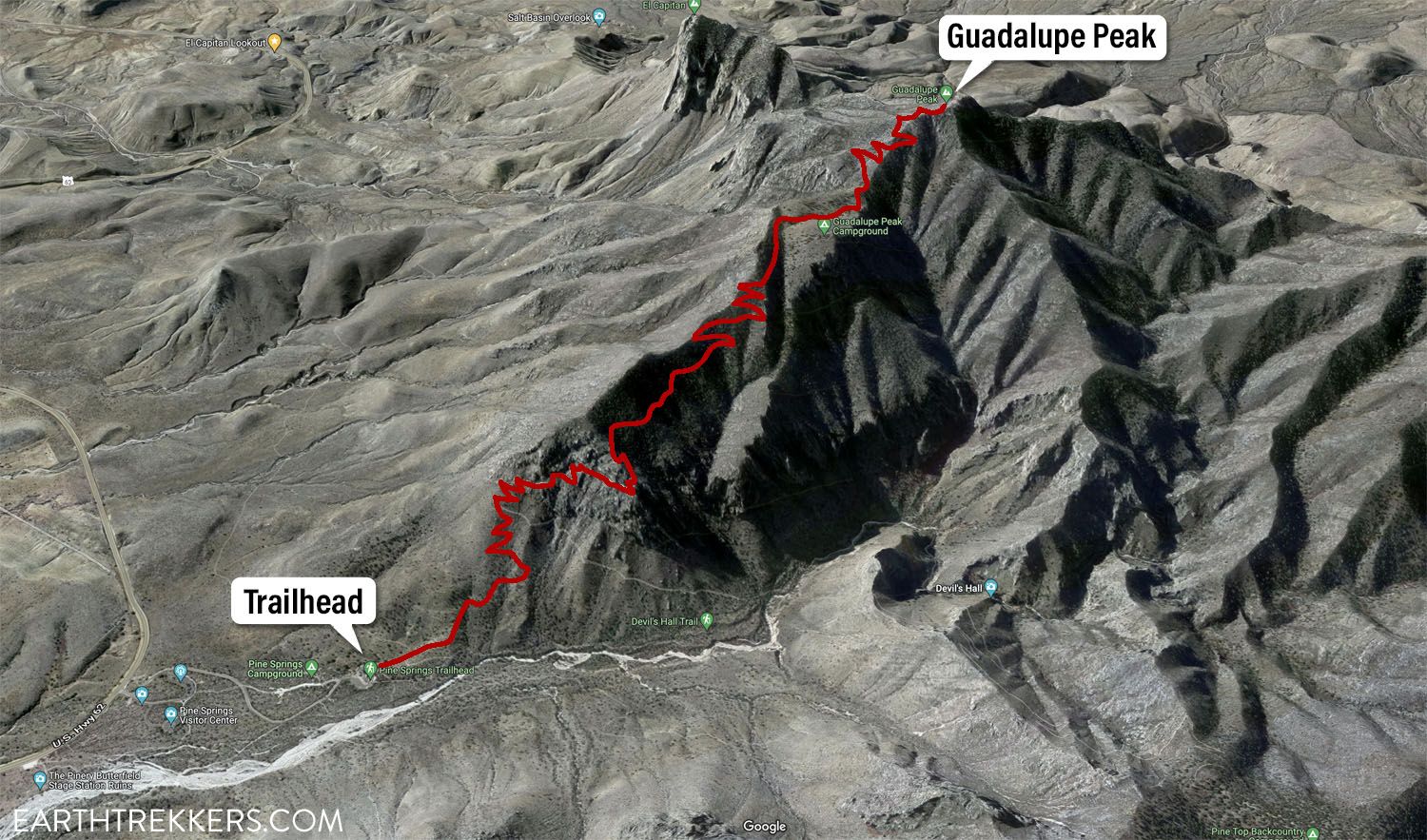
Guadalupe Peak Trail Map
Please practice the seven principles of Leave No Trace: plan ahead, stay on the trail, pack out what you bring to the hiking trail, properly dispose of waste, leave areas as you found them, minimize campfire impacts, be considerate of other hikers, and do not approach or feed wildlife.
How to Hike to Guadalupe Peak
Guadalupe Peak is one of the most popular hikes in Guadalupe Mountains National Park. Many people visit this park with the main goal of getting to the summit of this mountain.
With that being said, expect big crowds on the trails, especially during the spring and fall, when the weather is ideal for visiting this national park. Spring break, which occurs in mid-March, is one of the busiest times to be here.
We hiked to Guadalupe Peak on March 15, which was during spring break. Since we got an early start, crowds were low on the way up, but we passed lots of hikers on our way back down. Out of all of the trails we hiked in Guadalupe Mountains National Park, this trail was one of the busiest (hiking the McKittrick Canyon Trail to the Notch was also very busy).
It will take most people between 6 to 8 hours to do this hike. It can be done faster (we reached the summit in 2 hours) or longer. For a hike this long, pack a picnic lunch. Guadalupe Peak is a great spot for a picnic and to give your legs a rest before starting the big descent back down the mountain.
Getting to the Trailhead
The trailhead for Guadalupe Peak is called the Pine Springs Trailhead.
The best place to park is at the parking lot right next to the Pine Springs Trailhead. The trick is getting a parking space here because the parking lot fills up early. We were able to get one of the last spots at 7:30 am.
Once this parking lot fills up, the next closest place to park is next to the Pine Springs Visitor Center. From here, it is a flat, 0.4 mile walk one-way to get to the trailhead.
If the visitor center parking lot fills up, the third overflow parking lot is located much farther away, on Highway 62. From here, it is a 0.8-mile walk to the trailhead, which adds almost 2 miles onto the hiking stats above. Rolling out of bed early has its advantages!
There are restrooms next to the Pine Springs Trailhead.
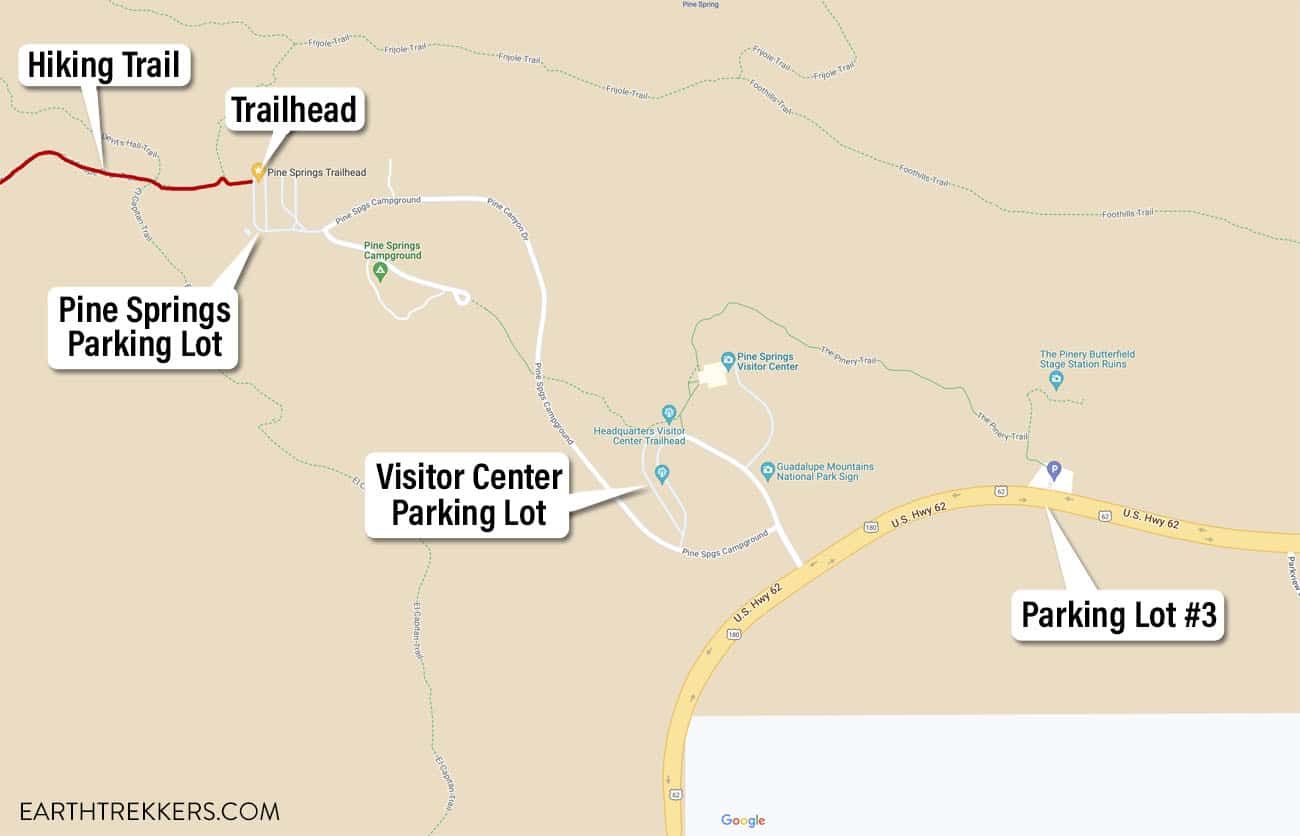
Parking Map
Hiking to Guadalupe Peak
The trailhead is located on the northwest corner of the parking lot. Less than a tenth of a mile into the hike, you will reach a trail junction. Take the middle trail, following the sign for the Guadalupe Peak Trail.
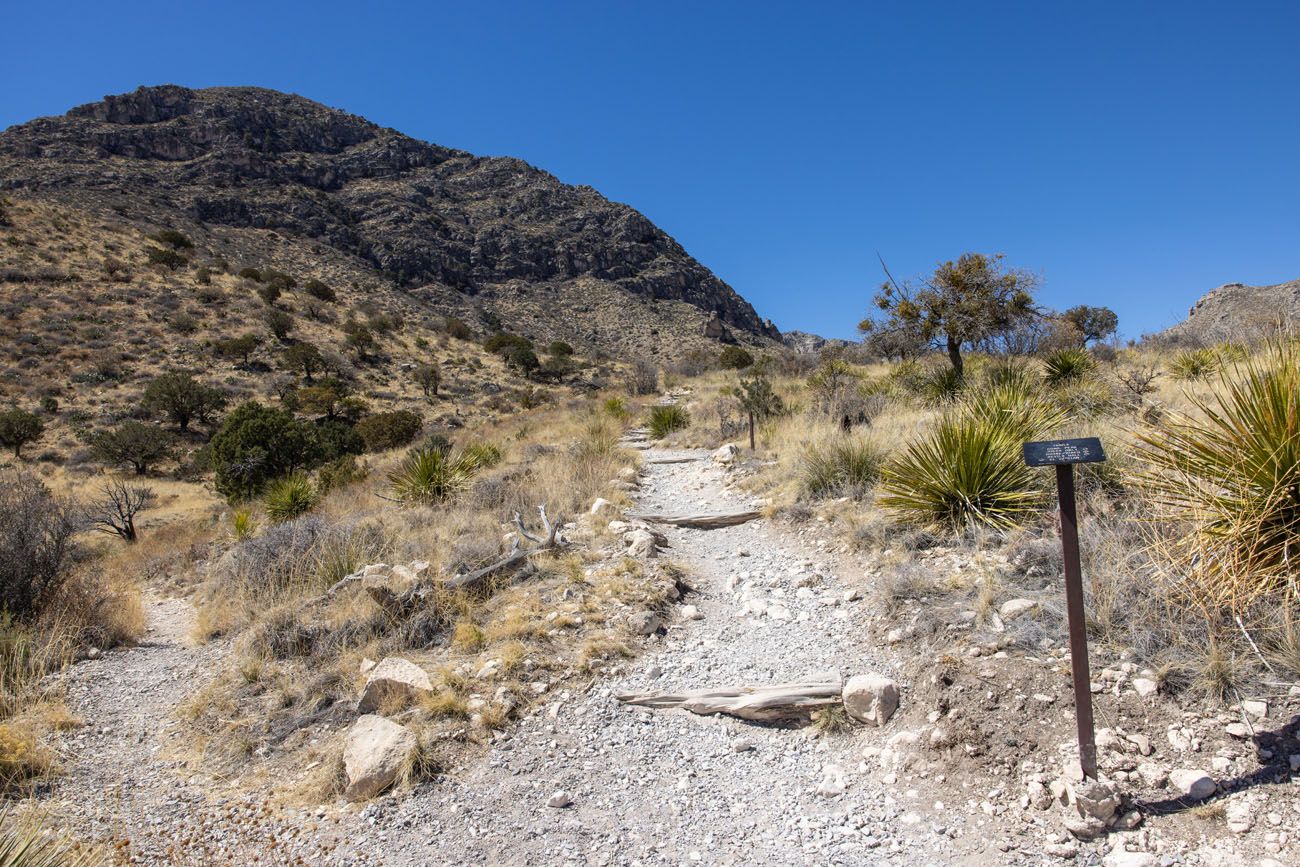
Trail junction. You will hike up and around the mountain in this photo but this is not Guadalupe Peak (you can’t see it yet).
Right from the start, the trail makes its ascent up into the mountains. The first mile is the toughest. Almost right away you enter a series of switchbacks. The trail here is steep, rocky, with some occasional huge stone steps thrown in along the way.
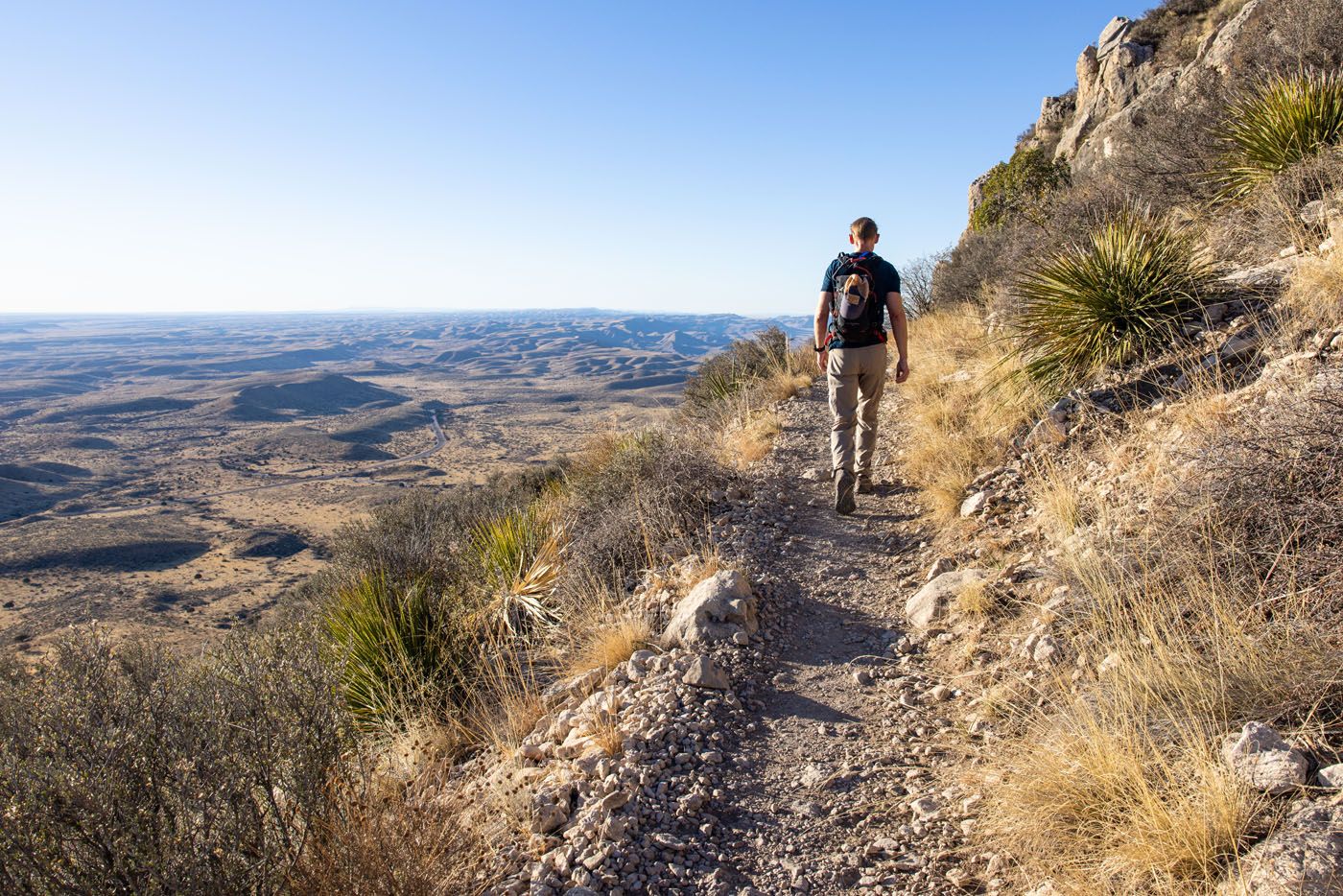
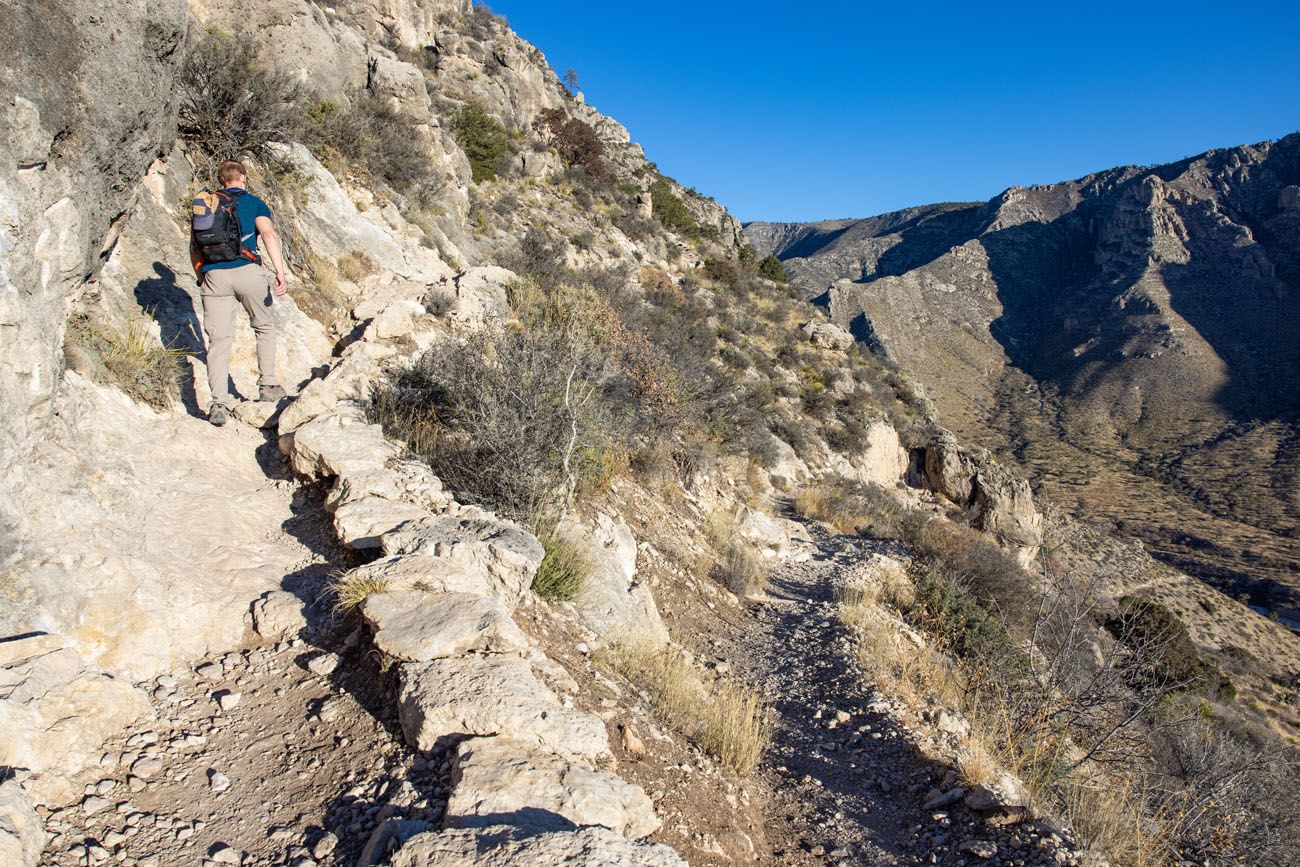
At 0.8 miles into the hike, you will reach another trail junction. This is marked with a sign that reads “no stock beyond this point.” Continue to follow the steeper trail uphill, to stay on the Guadalupe Peak Trail. If you take the narrower trail that leads back downhill, you will be heading to Devils Hall.
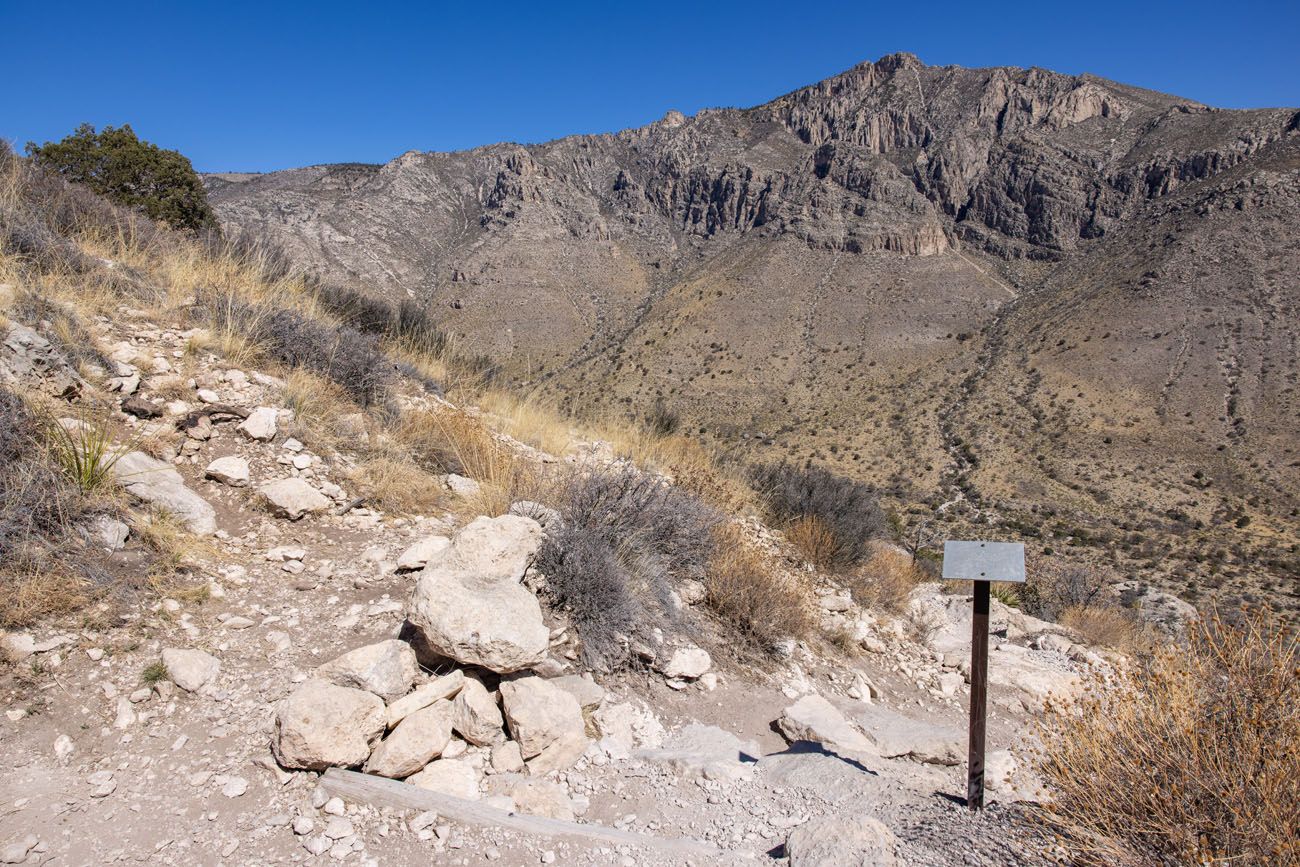
Stock Trail Junction
Mile two is still steep, but not quite as bad as the first mile. There will still be sets of stone steps, but there are also a few places where the trail levels out, at least for a little bit, to give you a brief break. But this part of the hike is one of the best. The views to the valley below, the parking lot, and Hunter Mountain are amazing.
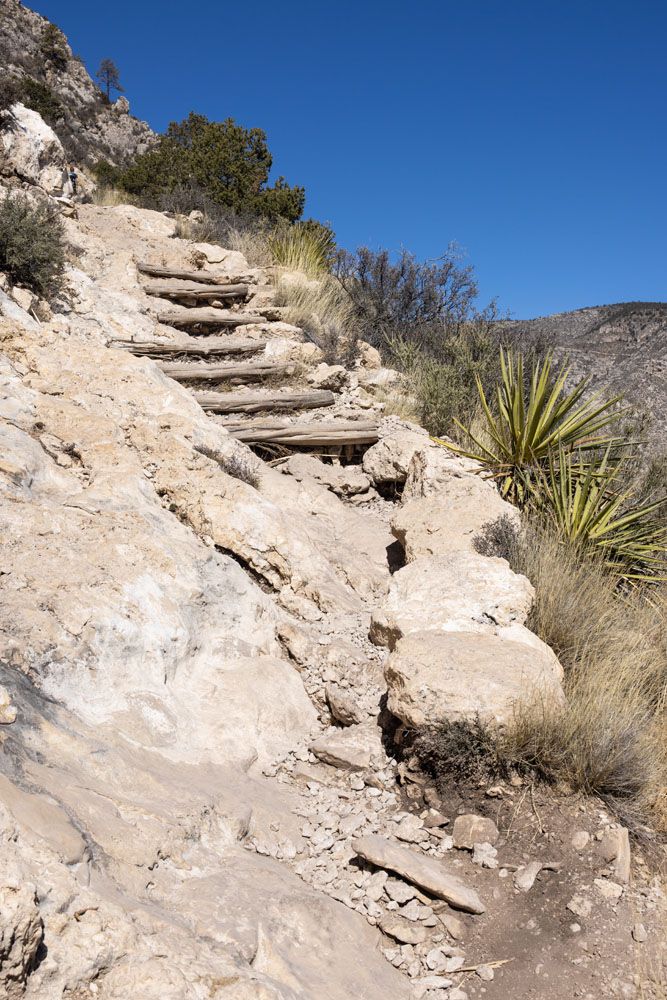
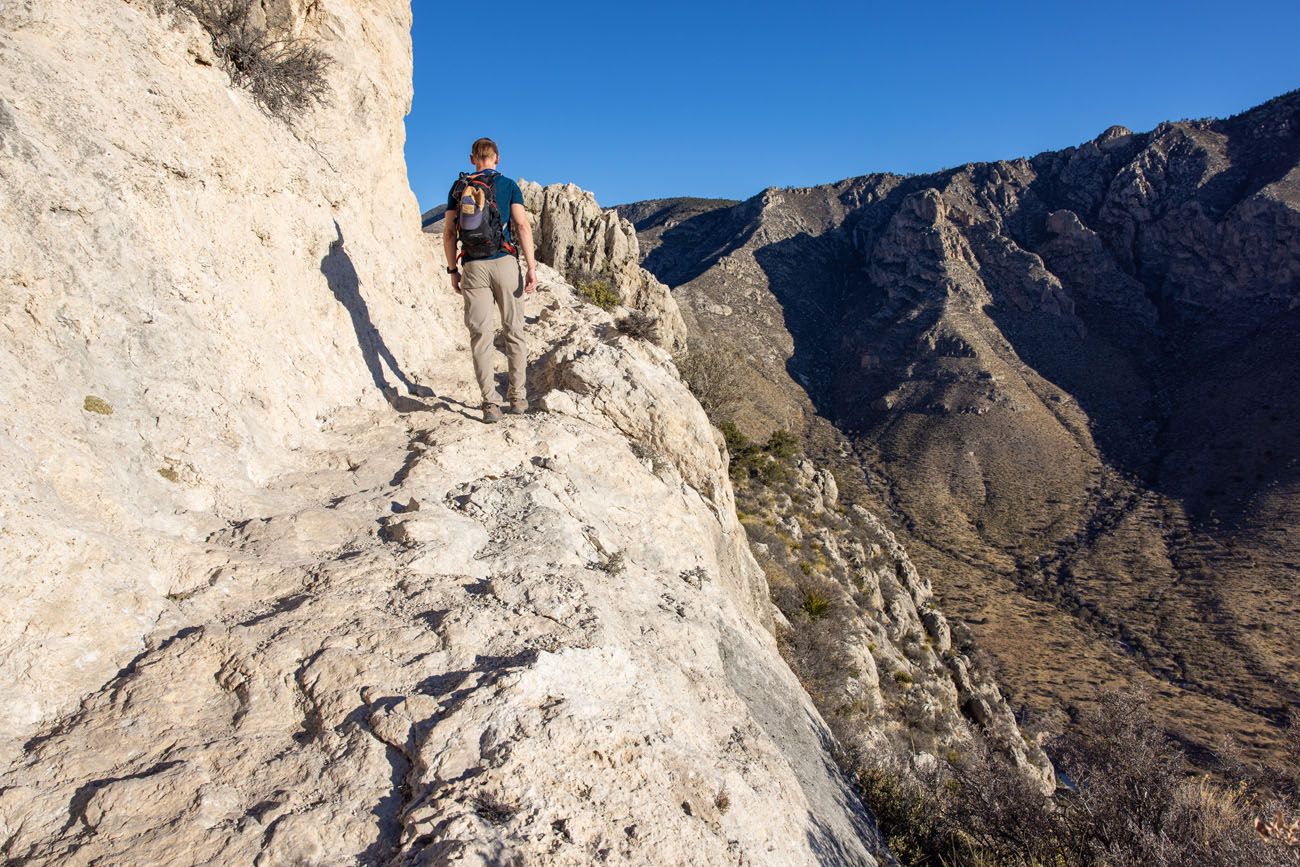
There are spots where the trail gets very narrow with a drop off on one side, as seen here.
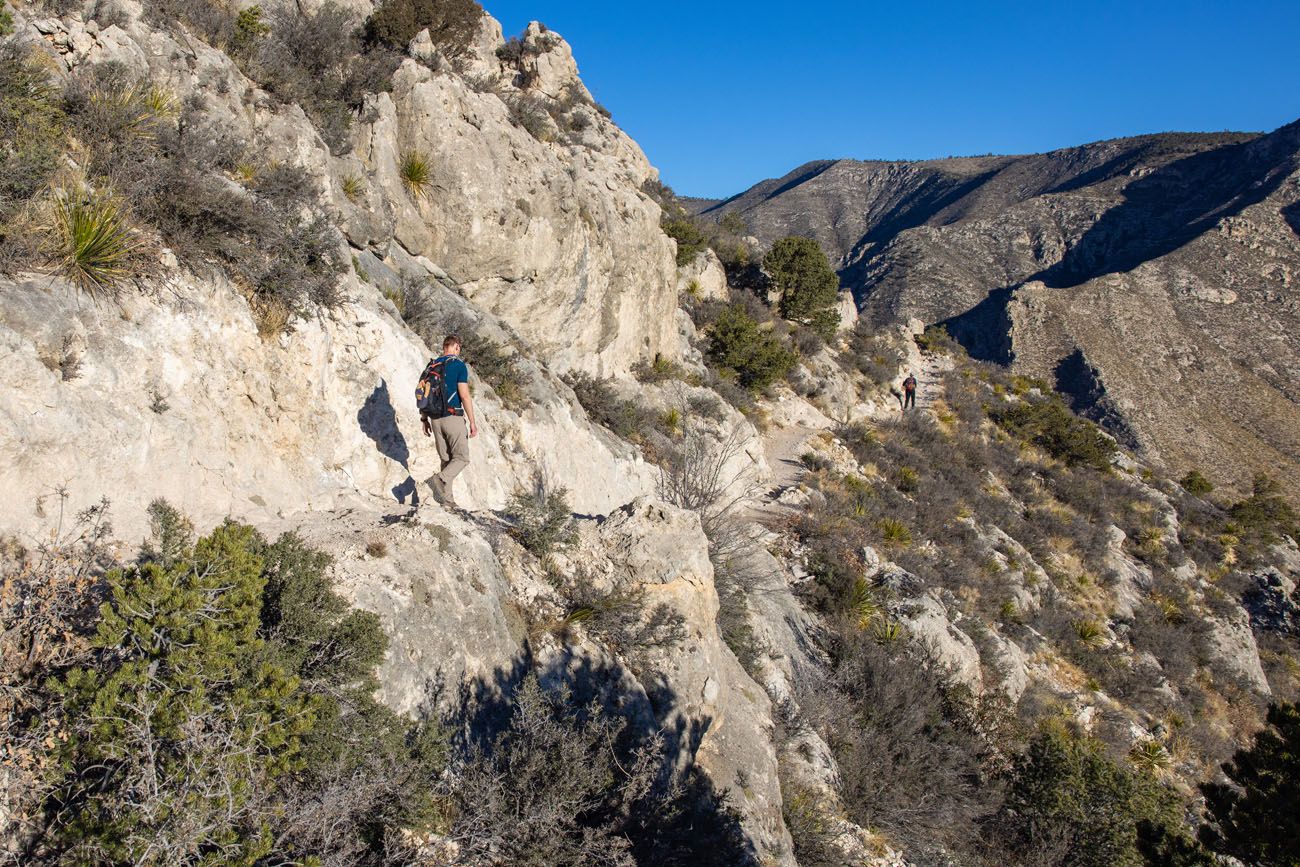
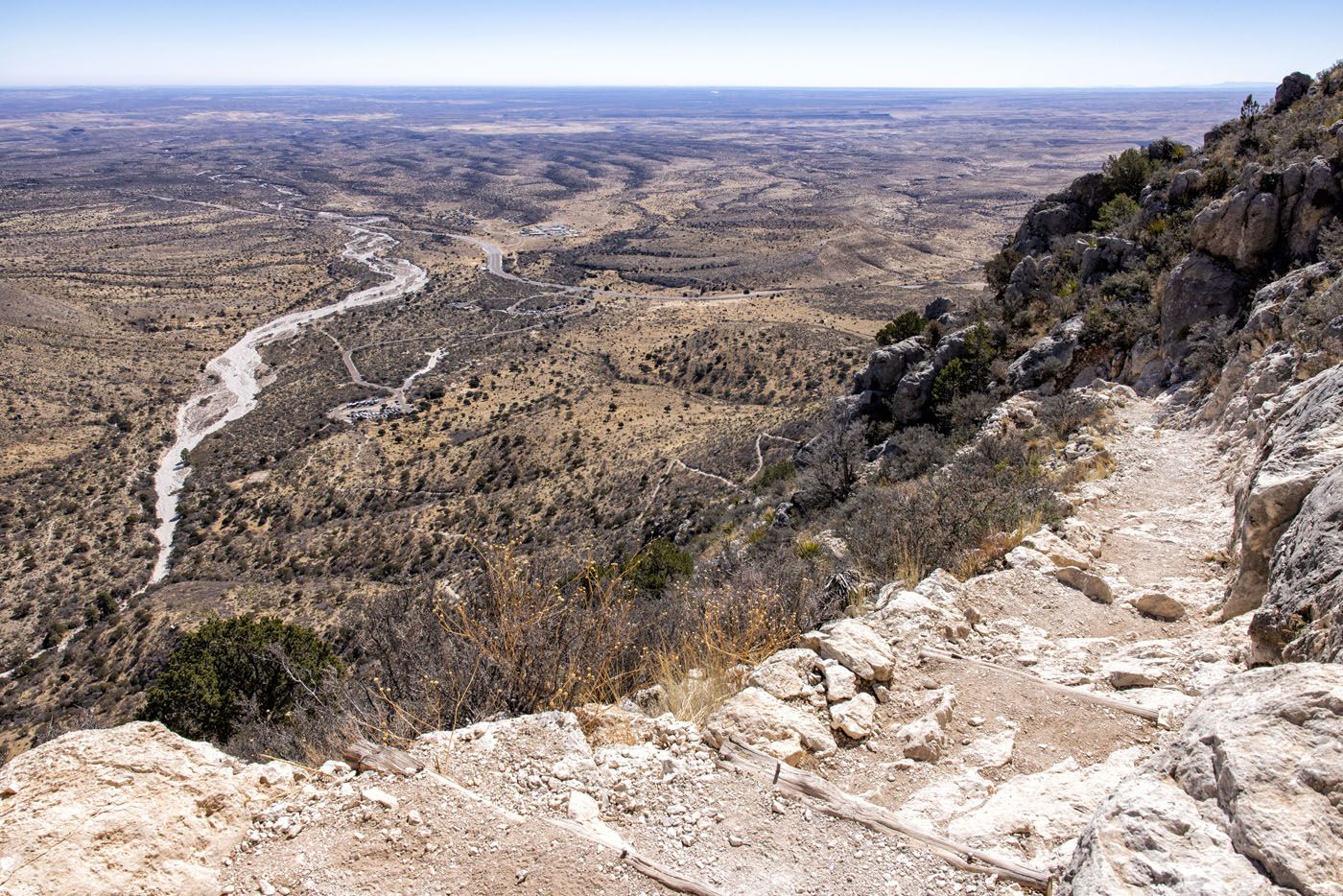
During the second mile, the trail winds around the backside of the mountain you’ve been hiking up, and parts of this trail will be shady.
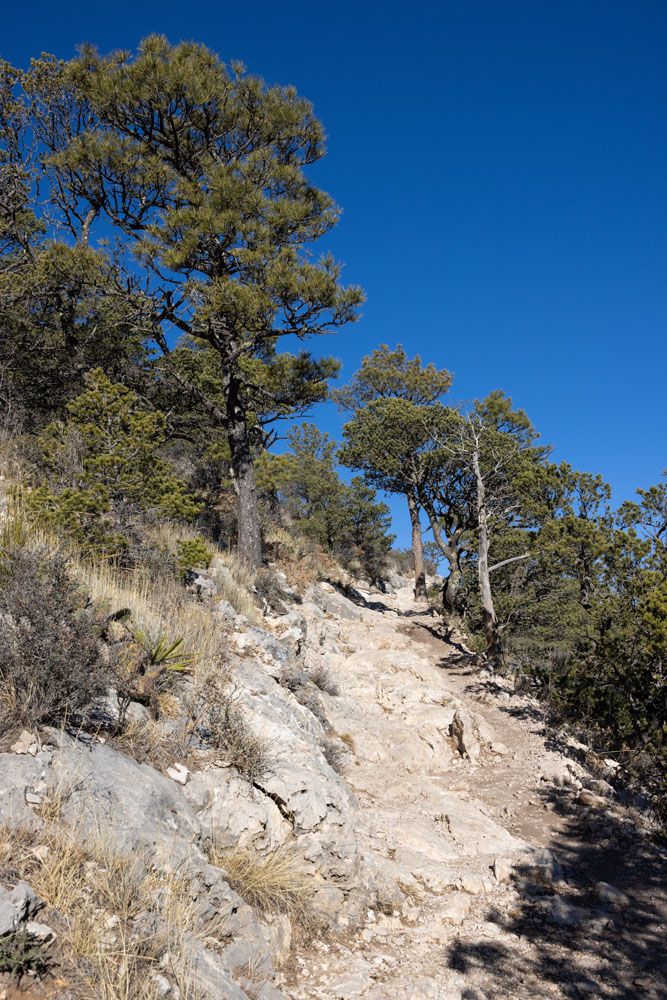
Mile three is the easiest mile on your way up to Guadalupe Peak. You are still hiking uphill, and it’s still challenging, but it’s not as steep as the first two miles. Once you reach the end of the third mile, Guadalupe Peak comes into view.
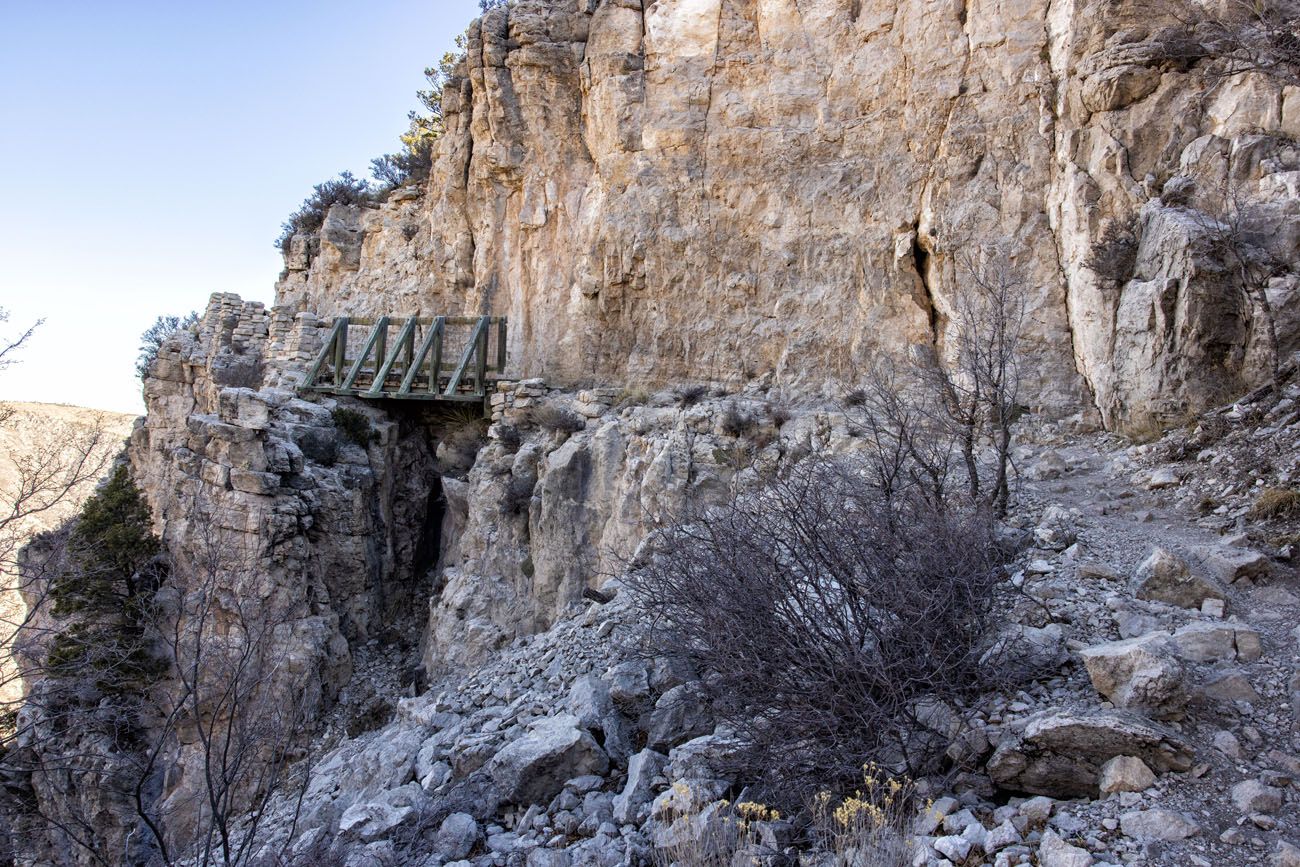
Bridge on the trail
The final mile is beautiful. Once again, you are hiking on a trail with panoramic views of Guadalupe Mountains National Park and Texas. Just before you get to the peak, the trail gets steeper and there are a few sections where the trail narrows and has a drop-off on one side. The trail is about 5 feet wide and if you have a fear of heights, this may be challenging for you.
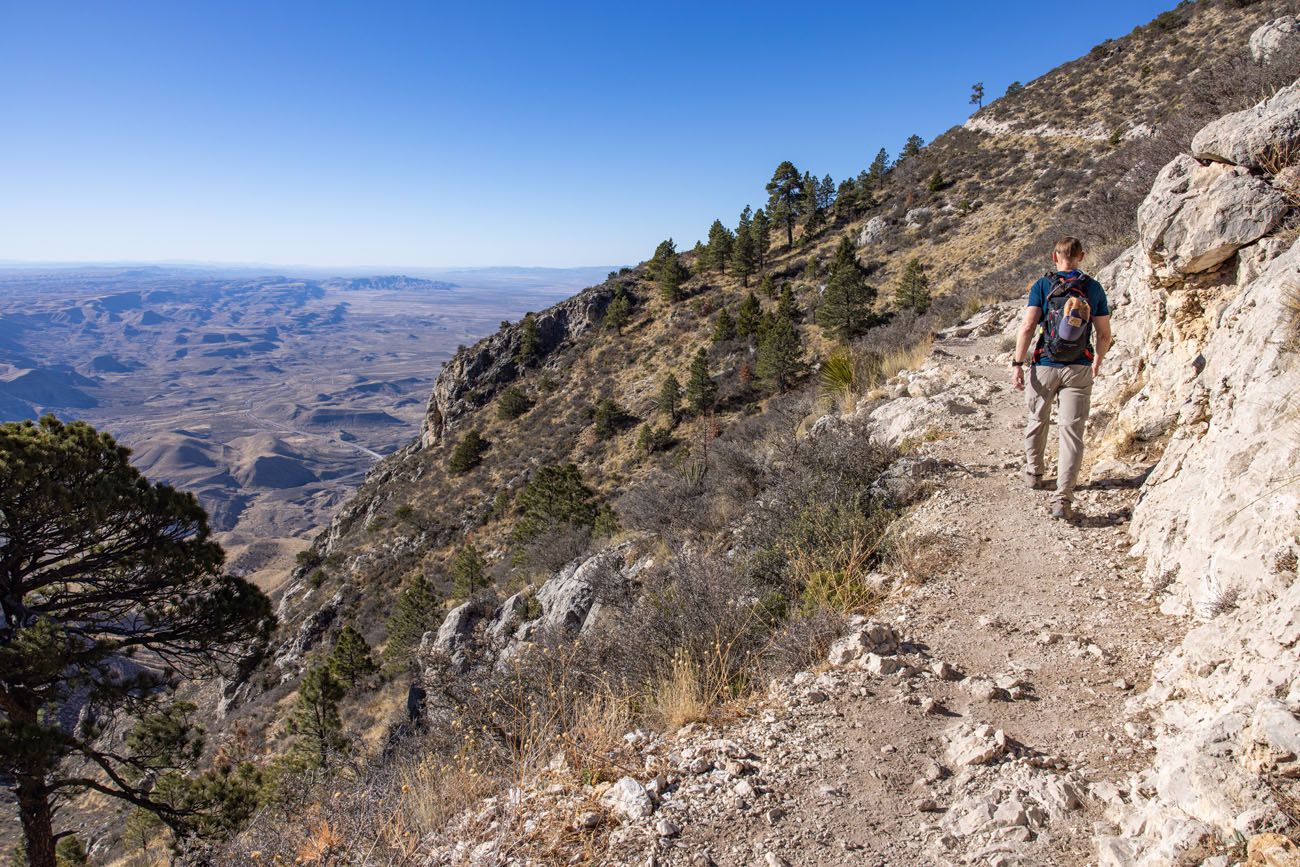
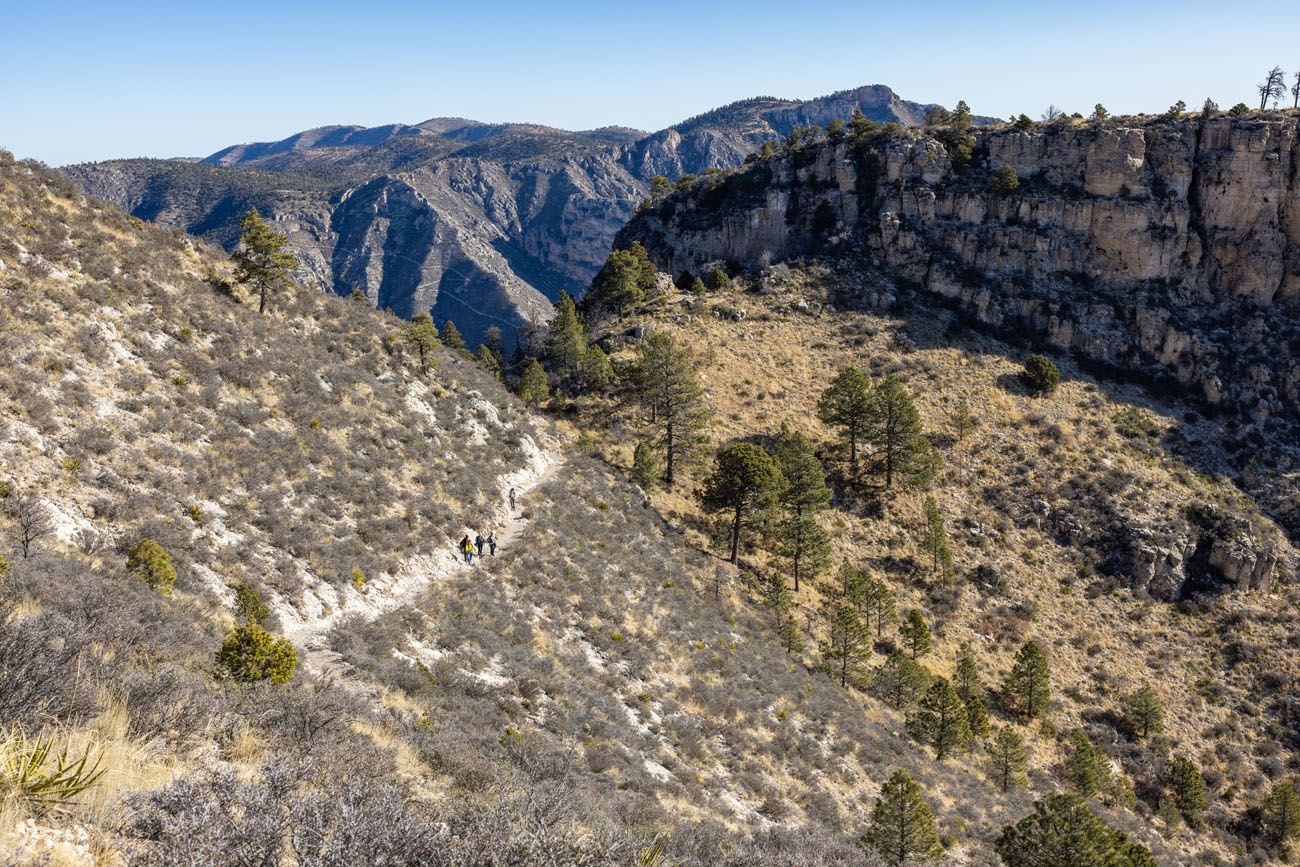
View from the trail
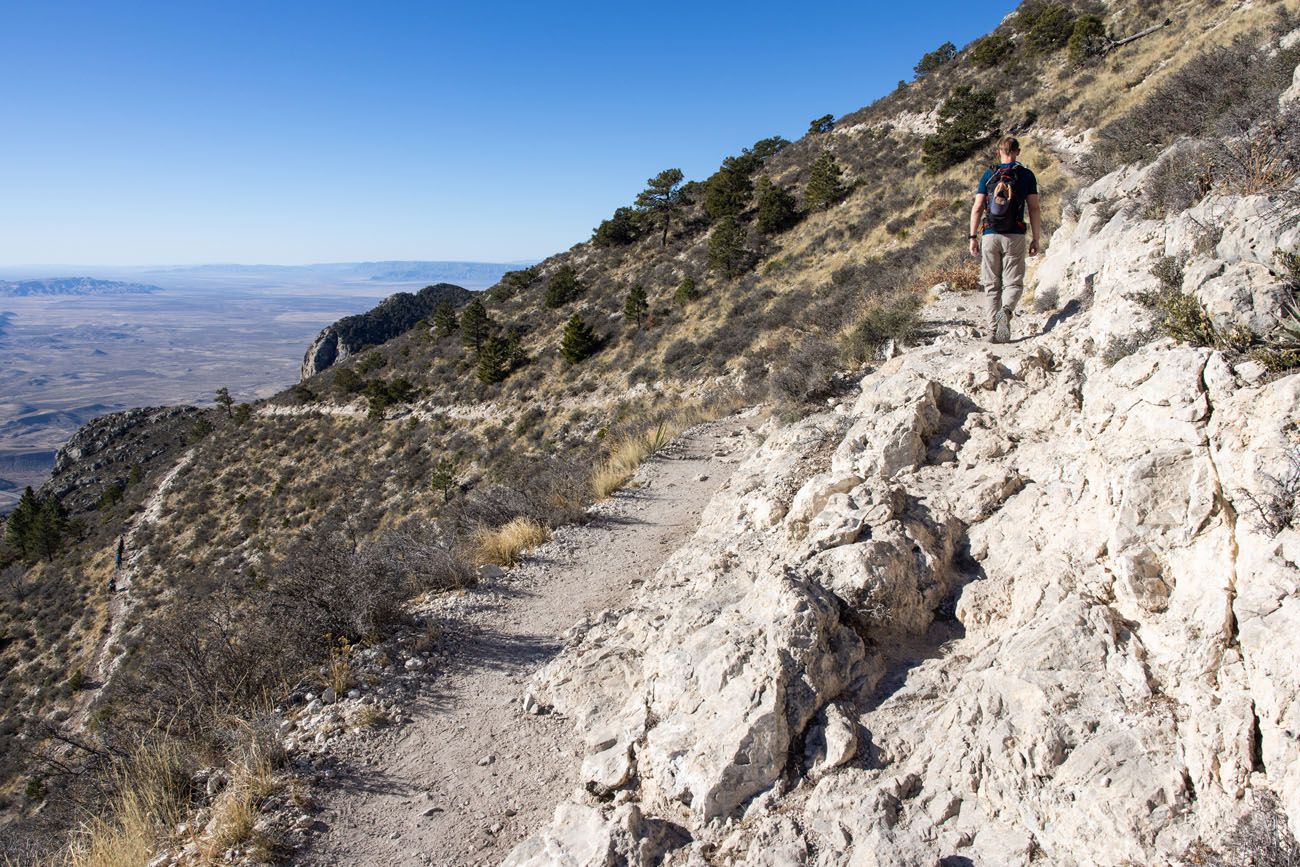
The final switchbacks
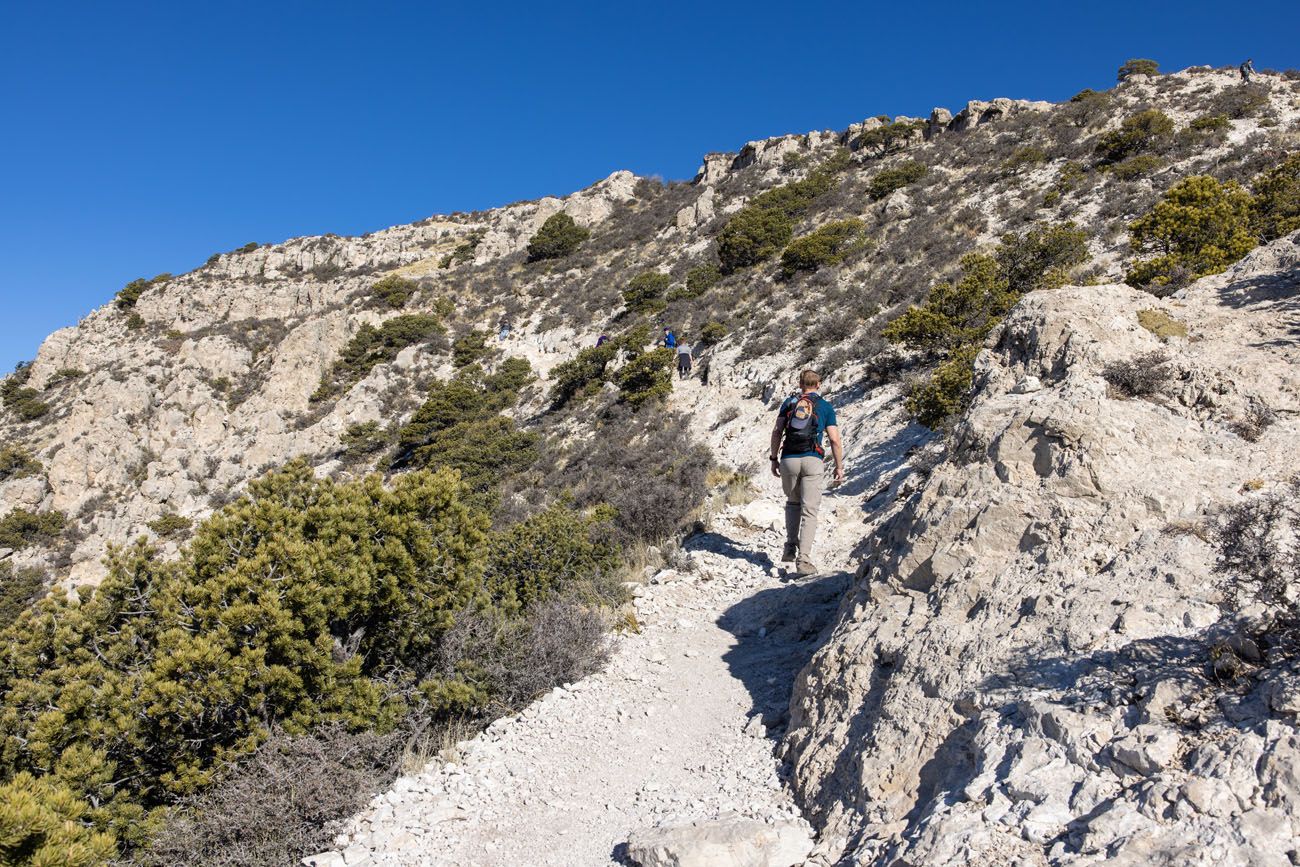
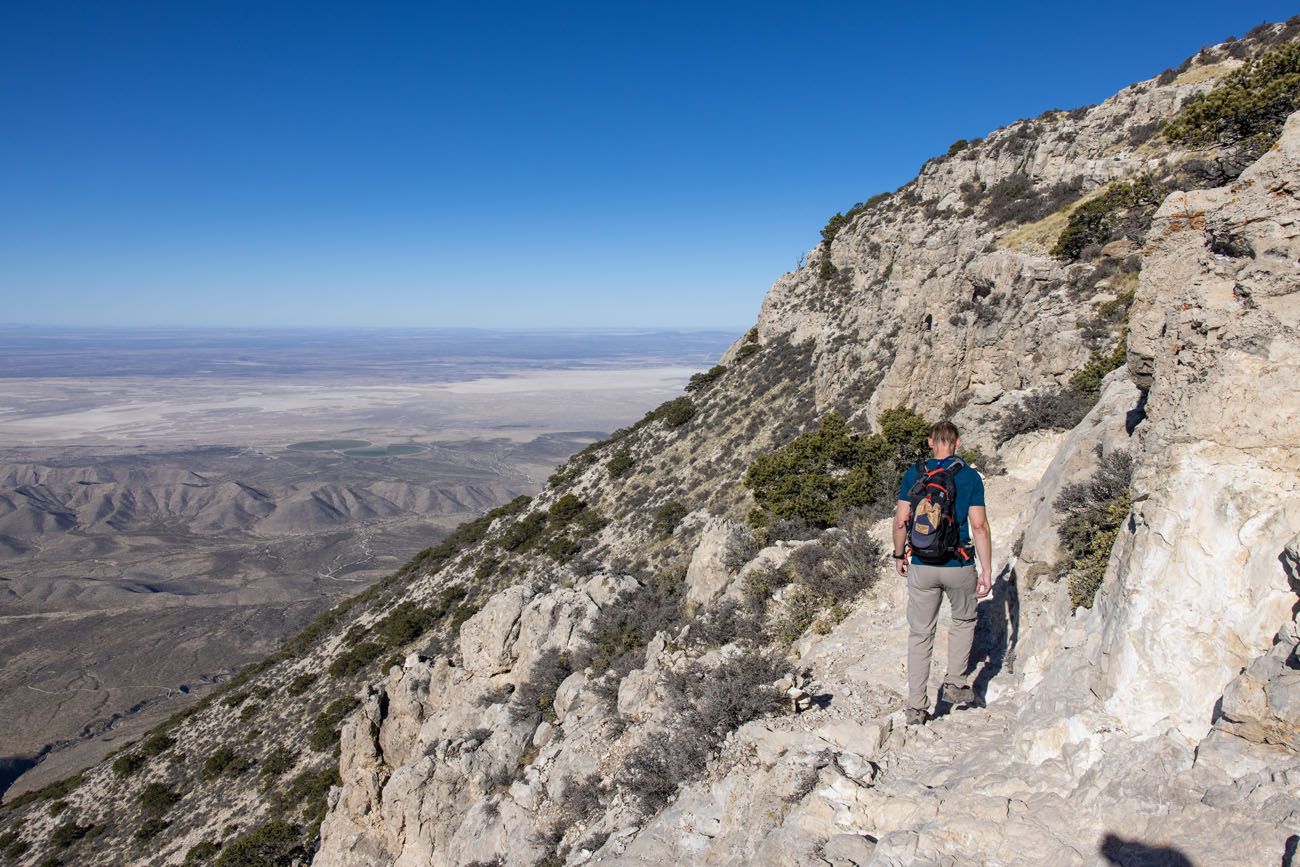
One last narrow section of trail, and one last steep climb, and then the summit!
Once at the top, enjoy the view!!
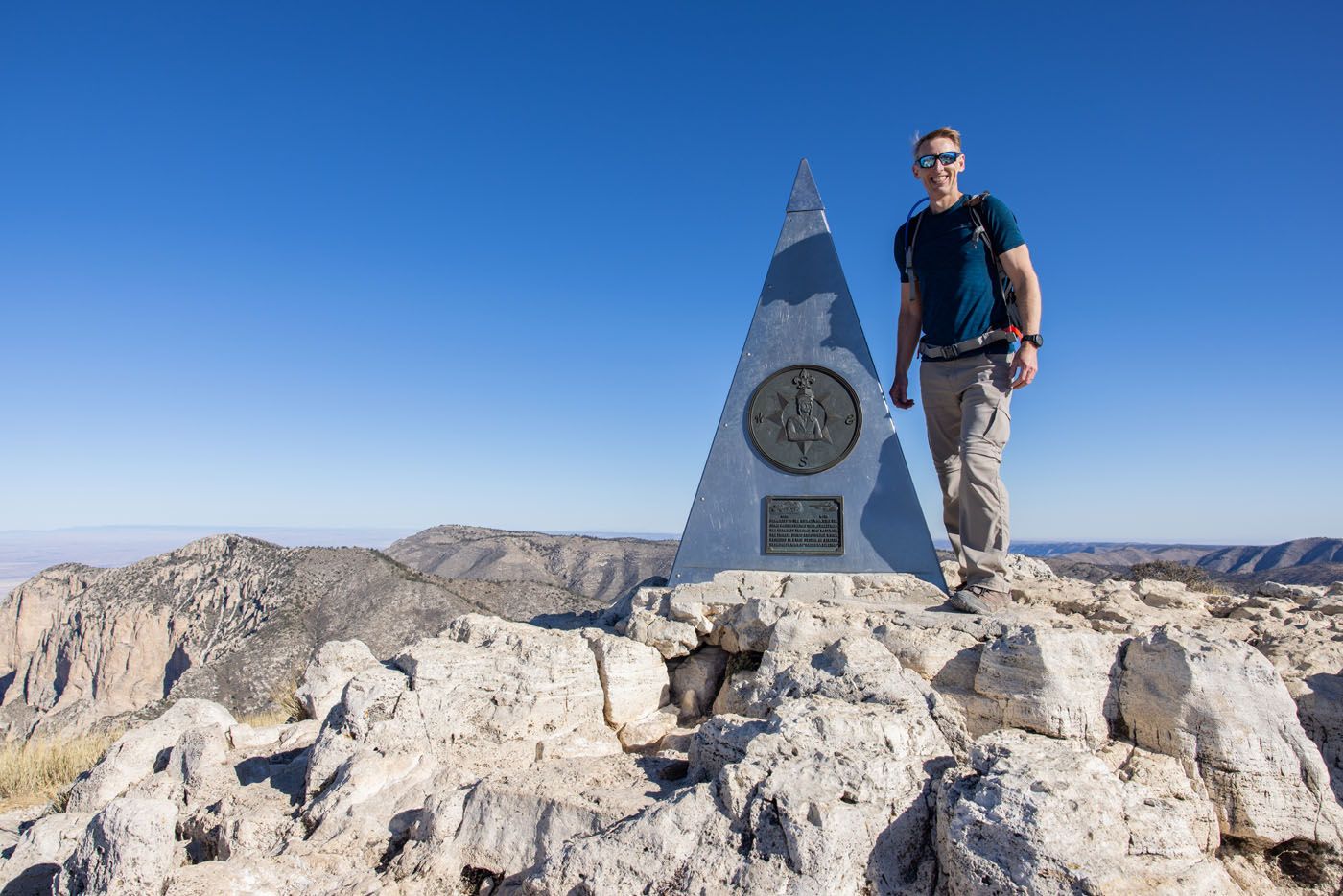
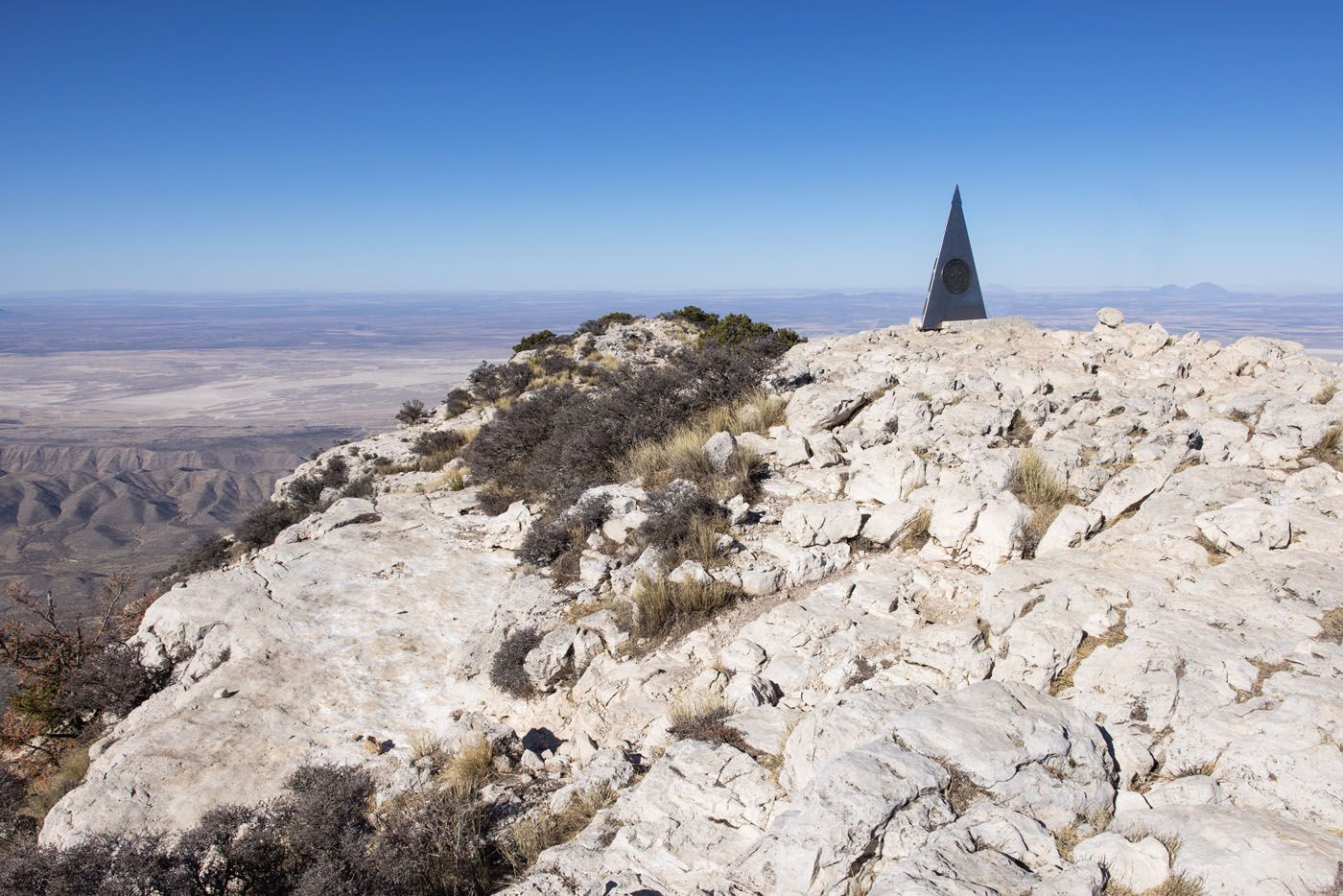
Guadalupe Peak
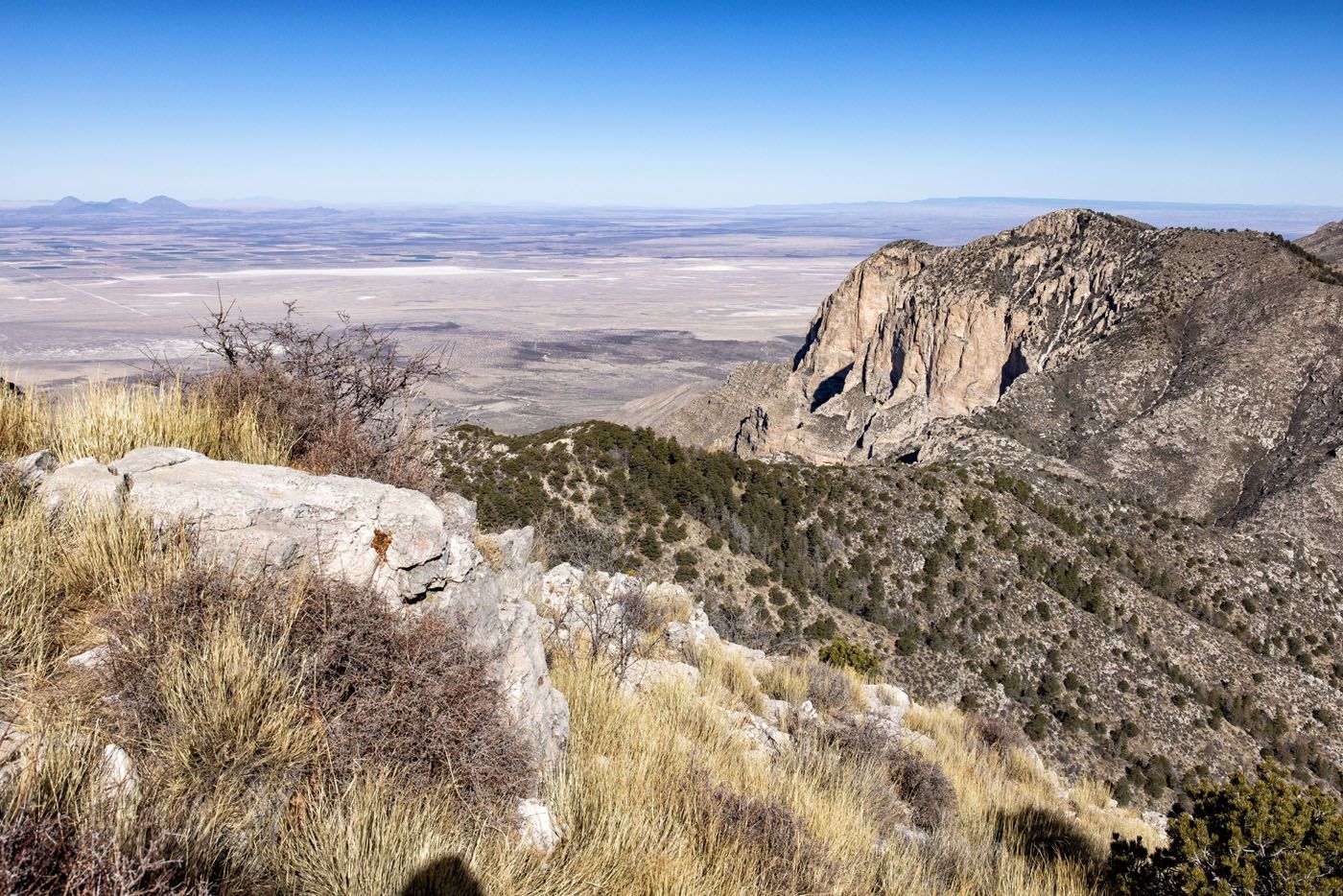
View from Guadalupe Peak
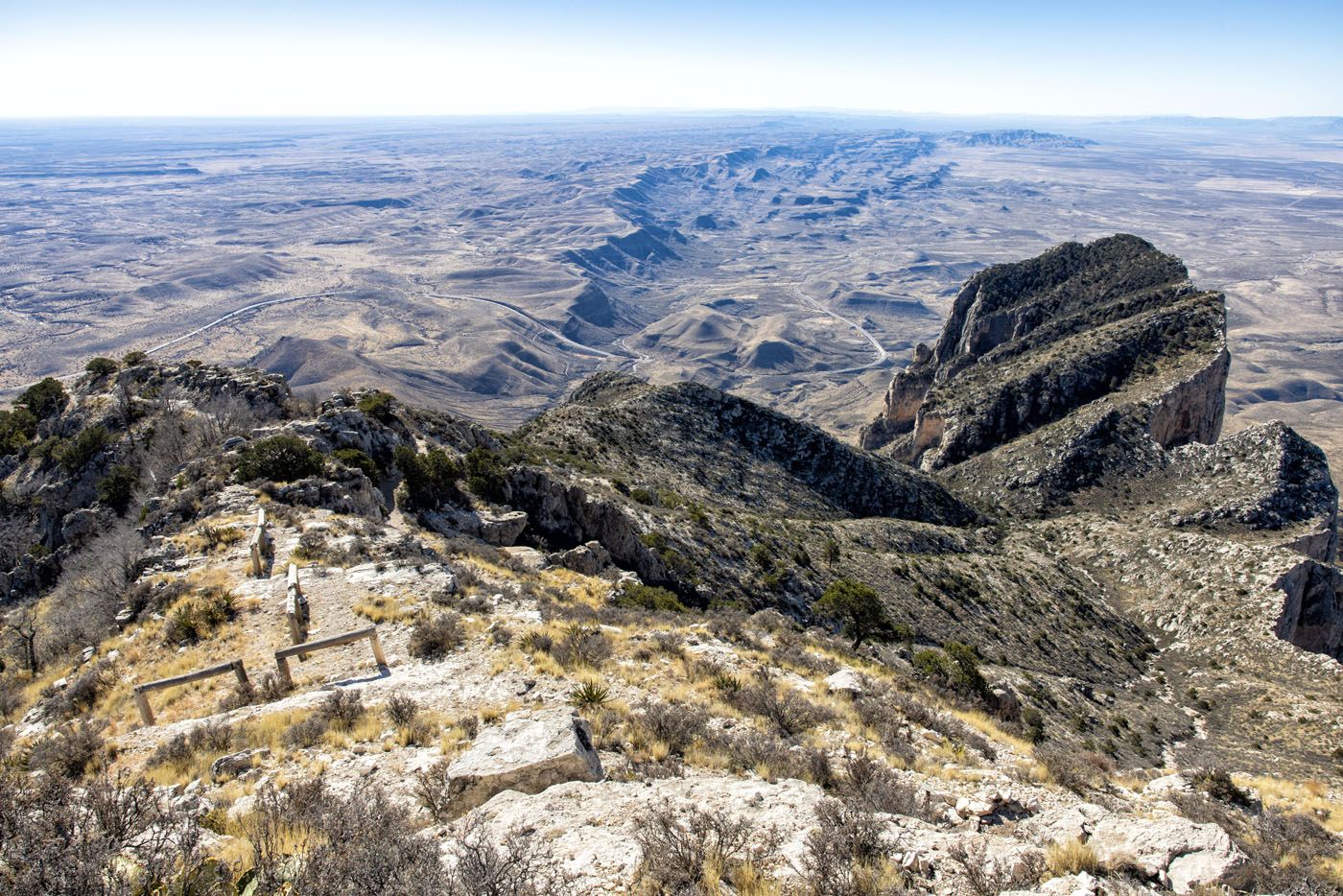
The view of El Capitan from Guadalupe Peak
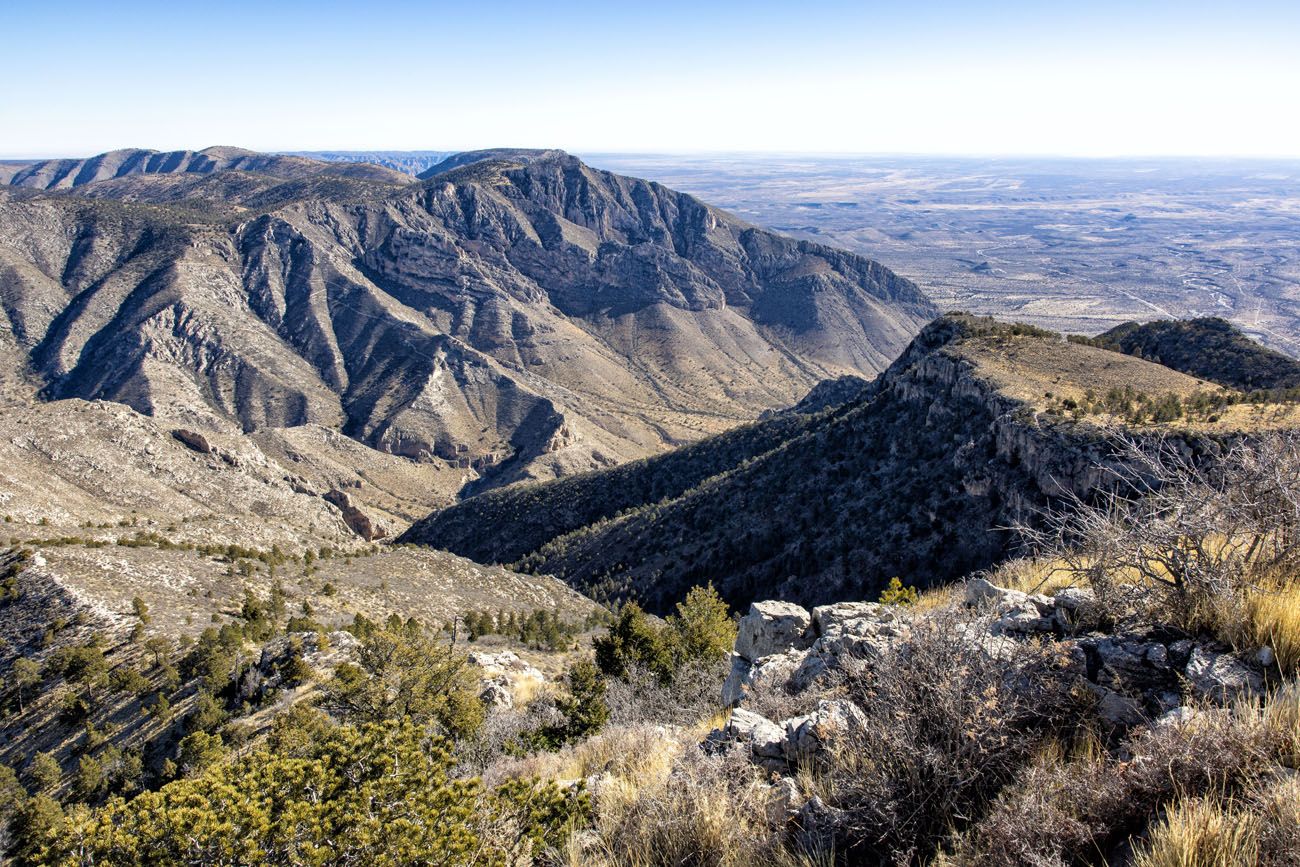
Hunter Peak
The Return Hike
From Guadalupe Peak, it is an entirely downhill walk to finish the hike. That might sound like a good thing, but hiking downhill, especially on a steep trail like this one, can be very fatiguing. If you have hiking poles, this is a good time to use them. The poles will take some of the stress off of your legs, which can help reduce leg and knee pain.
Adding on Devil’s Hall
Devil’s Hall is another great hike that shares the same trailhead with Guadalupe Peak. If you are very fit, you can add on Devil’s Hall to Guadalupe Peak.
Distance: 11.25 miles round trip
Total Ascent: 3,450 feet
Lowest Elevation: 5,850 feet
Highest Elevation (Guadalupe Peak): 8,751 feet
Time: 6 to 10 hours
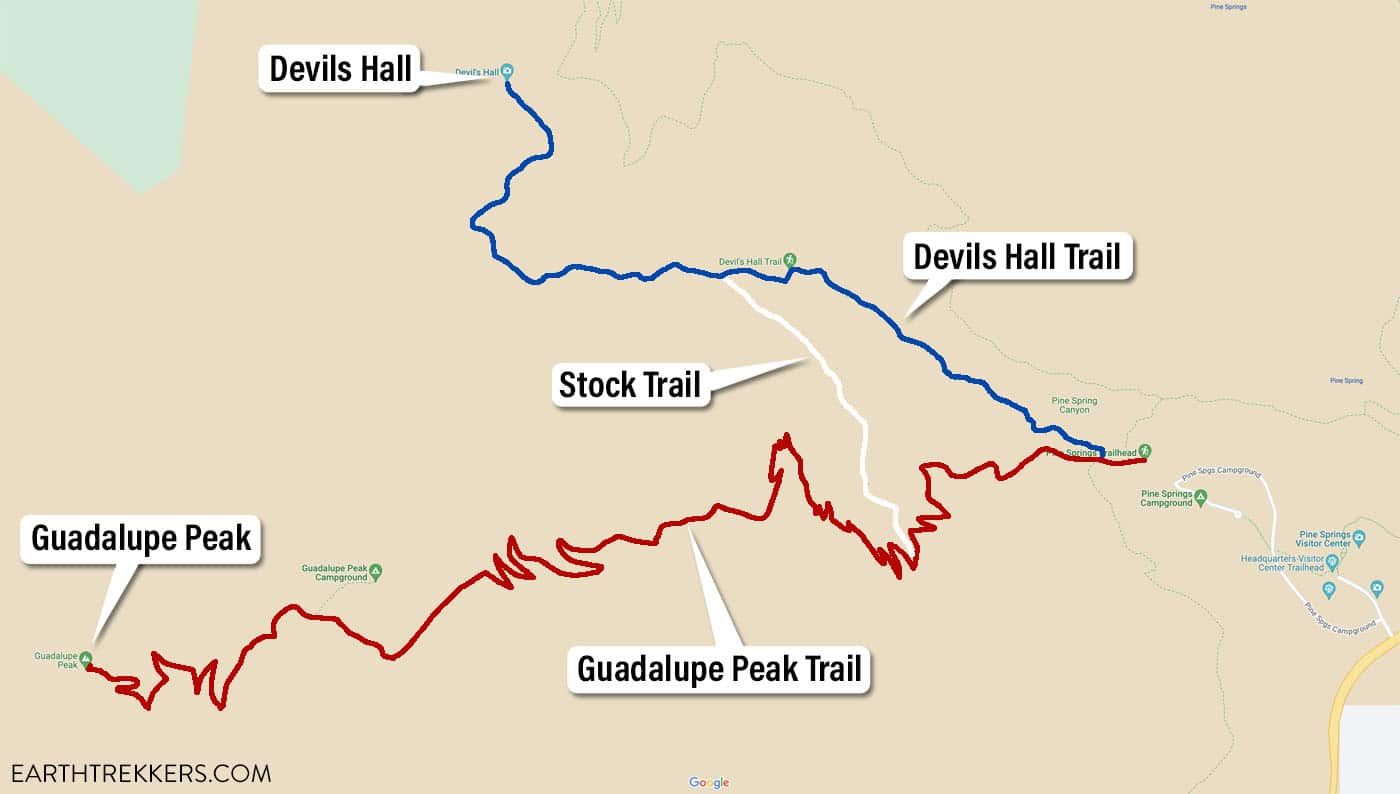
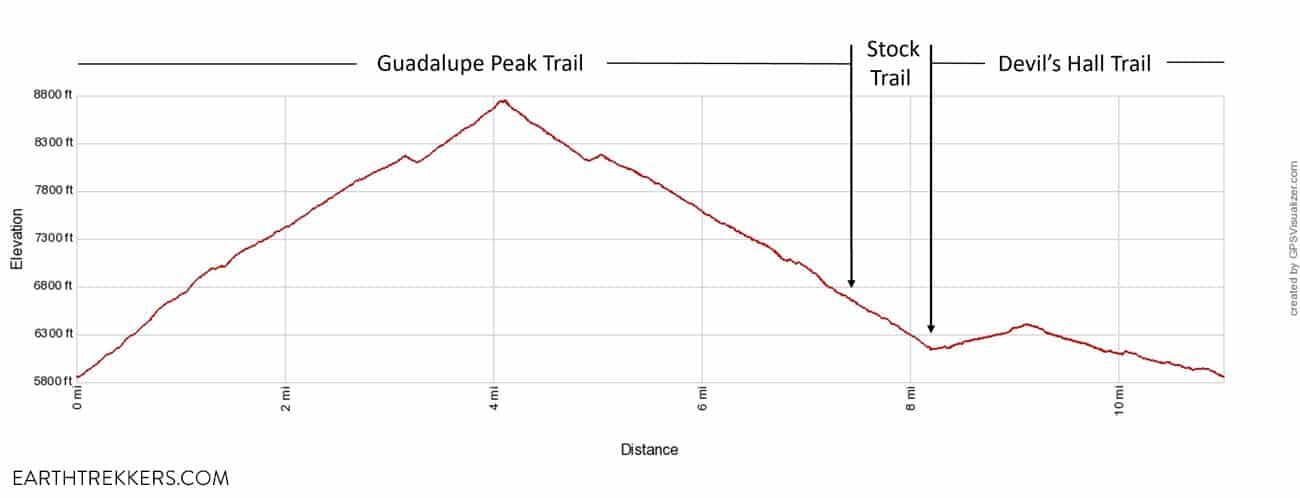
Guadalupe Peak and Devils Hall Elevation Profile
Hike to Guadalupe Peak first.
Then, to get to Devil’s Hall, as you hike back to the trailhead, keep a lookout for the trail junction with the sign that reads “no stock beyond this point.” Take this trail to the left. This stock trail heads downhill for 0.75 miles, joining up with the Devil’s Hall Trail. Basically, it’s a shortcut, so you don’t have to walk to the Pine Springs Trailhead and then start the Devil’s Hall Trail.
Once you reach the Devils Hall Trail, continue it to the end (about 1 mile). Then, to finish this hike, walk the Devil’s Hall Trail back to the trailhead.
We did this and it is exhausting. The rock scrambling on the Devil’s Hall Trail is relatively easy, but by the time we got to this point, both Tim and I were tired. The rocks are slippery and it takes some concentration to watch where you are putting your feet. It’s easy to slip and fall even if you aren’t tired…after Guadalupe Peak, this becomes even more challenging.
I only recommend adding Devil’s Hall onto Guadalupe Peak if you are a very fit hiker.
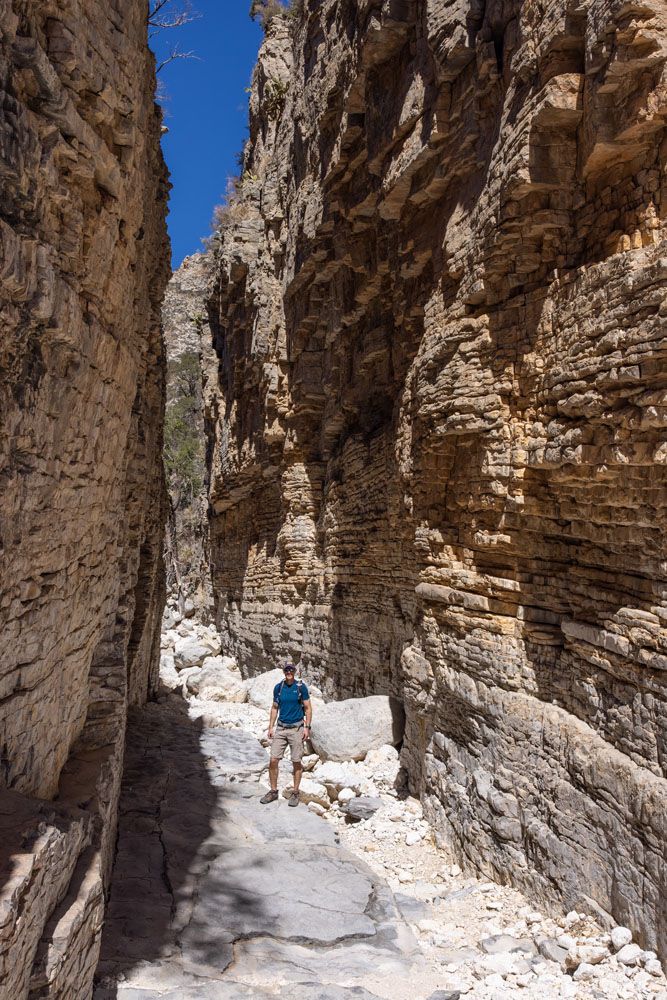
Devil’s Hall
Tips to Have the Best Experience
Start the hike early, ideally by 7:30 am (but even earlier is better). By starting early, you can get one of the parking spaces in the trailhead parking lot. You will also get ahead of the crowds and hike in the cooler part of the day.
Cellular Service. We had cellular service on Guadalupe Peak (we use Verizon). Other hikers were texting and calling friends and family to let them know their achievement.
Beware of the wind. On a windy day, winds can gust up to 80 mph on top of Guadalupe Peak. If possible, do not do this hike on a windy day. We had to postpone this hike for one day, to avoid the windy conditions.
Get updates on road conditions and trail closures, as you plan your trip and just before your visit, on the National Park Service website.
What to Bring on the Hike
- Hiking Shoes
- Water: The National Park Service recommends one gallon of water per person during the summer months. We carried 2 liters of water per person but the temperature when we did this ranged from 40°F to 65°F.
- Sunscreen
- Hat
- Sunglasses
- Lunch and snacks
- Hiking poles
- Camera or smartphone
If you are new to hiking or are curious about what you should bring on a hike, check out our Hiking Gear Guide. Find out what we carry in our day packs and what we wear on the trails.
If you have any questions about how to hike to Guadalupe Peak, or if you want to share your experience, let us know in the comment section below.
More Information for Your Trip to Texas
MORE HIKES IN GUADALUPE MOUNTAINS: The Devil’s Hall Trail is a fun hike to unique looking canyon. We also have detailed guide on how to hike the McKittrick Canyon Trail to Pratt Cabin, the Grotto, and the Notch. And the Permian Reef Trail is one of the most underrated hikes in the park.
BEST OF GUADALUPE MOUNTAINS: Read our article Best Things to Do in Guadalupe Mountains National Park for a full list of things to do, plus important information and helpful tips to plan your visit here.
CARLSBAD CAVERNS NATIONAL PARK: Carlsbad Caverns sits right beside Guadalupe Mountains National Park. Learn how to plan your visit in our article Best Things to Do in Carlsbad Caverns National Park.
BIG BEND NATIONAL PARK: Check out our Big Bend National Park Travel Guide for important travel information, sample itineraries, and how to plan your visit. Don’t miss our article Best Things to Do in Big Bend for great things to do in the park.
ROAD TRIP IDEA: Learn how to combine Guadalupe Mountains with White Sands, Carlsbad Caverns, and Big Bend National Park in our 10 day Texas Mexico Road Trip Itinerary.
TEXAS: Read all of our articles about Texas in our Texas Travel Guide.
NATIONAL PARKS: In our Guide to the US National Parks, get the full list of national parks with important travel planning information, such as things to do in the parks and sample itineraries.
If this is part of a bigger road trip through the USA, visit our United States Travel Guide for more inspiration and travel planning tips.
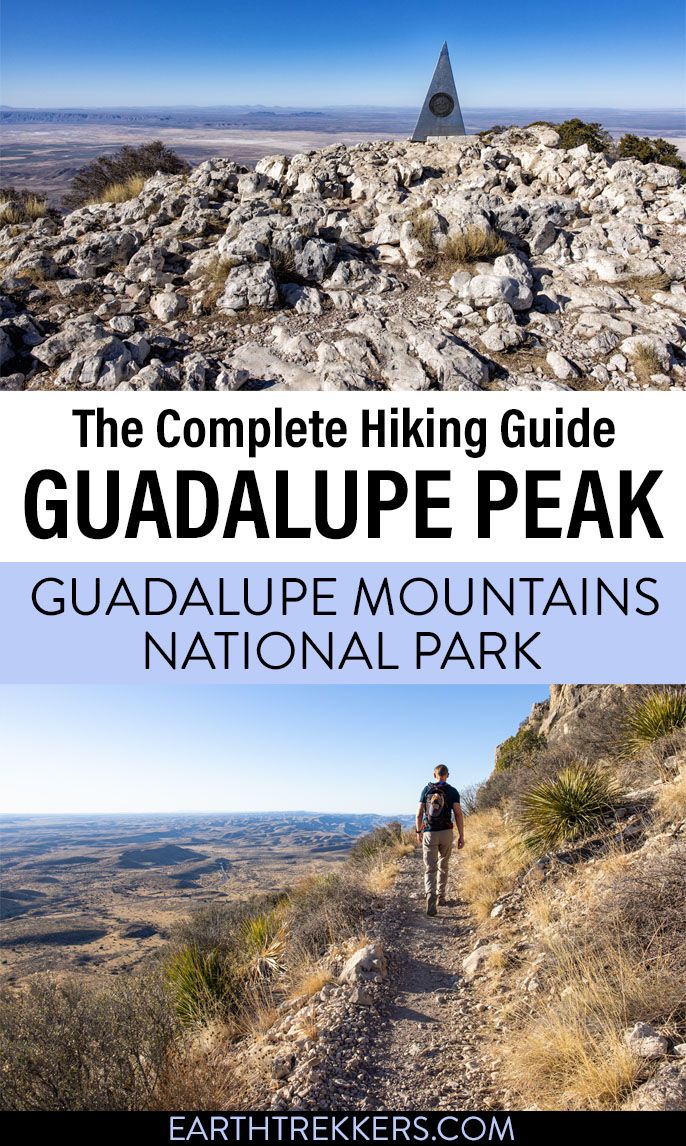
All rights reserved © Earth Trekkers. Republishing this article and/or any of its contents (text, photography, etc.), in whole or in part, is strictly prohibited.
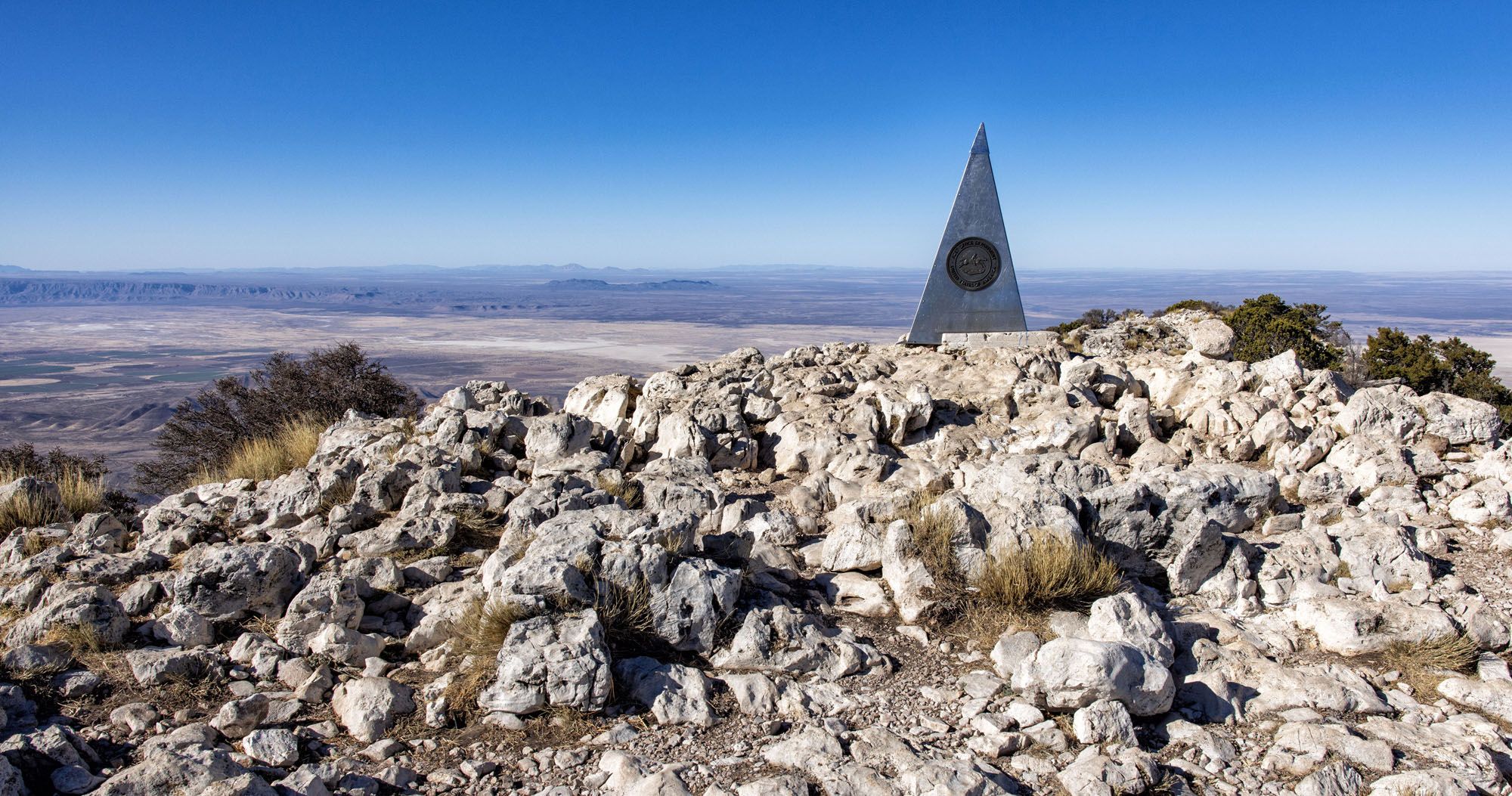
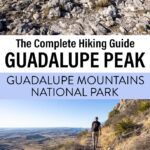

Comments 5